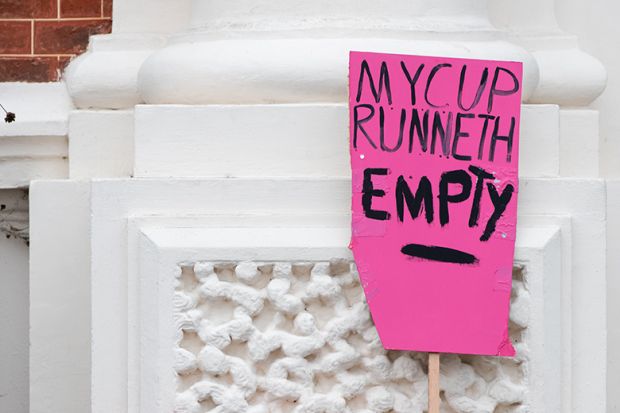A final round of ballot results has left the UK’s main higher education union with a mandate to strike at less than four in 10 of the institutions that it polled.
Announcing on 5 November the results of its ballot on a walkout over pay and working conditions, the University and College Union said that 70.1 per cent of members who voted backed the action.
However, while 52 branches with a “yes” vote hit the 50 per cent turnout threshold that is legally required for industrial action in much of the UK, 89 fell short or voted “no”. Two institutions in Northern Ireland, where the turnout threshold does not apply, also supported a strike.
The results were announced less than 24 hours after the UCU reported a 76 per cent “yes” vote for strike action over cuts to pensions provided by the Universities Superannuation Scheme. However, 31 of the 68 campuses where ballots were held failed to achieve a 50 per cent turnout.
Across both disputes, the UCU now has a mandate to strike at 58 universities: 21 over pay, 33 over pay and pensions, and four over the USS only. This is out of 152 institutions that were polled in total.
Jo Grady, the UCU’s general secretary, claimed that the combined ballot results gave the union “a big mandate to take strike action, at a time of our choosing”.
“This result is a clear vote of no confidence in the so-called leaders of our universities, with staff telling them in no uncertain terms that they have had enough of pay and working conditions being run into the ground,” Dr Grady said.
At the heart of the pay dispute was employers’ offer of a 1.5 per cent minimum rise for 2021-22, with unions demanding a £2,500 uplift instead, as well as action on inequality, casualisation and workload issues.
But the Universities and Colleges Employers Association said the results of the ballot on the issue were “a clear indication that the great majority of university union members, as well as wider HE employees, understand the financial realities for their institution”.
“These disaggregated ballot results are disappointing for UCU, and [its higher education committee] now faces awkward discussions and has very difficult decisions to make regarding strike action,” a Ucea spokesman said.
Branches falling short of the 50 per cent threshold in the pay ballot included the universities of Exeter, Oxford and Southampton, Cardiff and Newcastle universities, and Queen Mary, University of London.
The UCU, which had previously indicated that strikes could take place before Christmas, has said that its higher education committee will meet on 12 November to decide on next steps, including “whether and when to re-ballot some branches”.
If strikes go ahead, it would be the fourth round of widespread walkouts in little over three years, further disrupting the education of undergraduates who have also seen their on-campus learning significantly interrupted by the coronavirus pandemic.
chris.havergal@timeshighereducation.com
UCU pay and working conditions ballot 2021: the results
Institutions supporting strike action and passing 50 per cent threshold
Institutions supporting strike action but not passing 50 per cent threshold
Institutions not in support of strike action
| Institution | Turnout (%) | Yes vote (%) |
| Bishop Grosseteste University | 53.5 | 23.7 |
| Bournemouth University | 57.2 | 49.7 |
| Harper Adams University | 19.6 | 42.1 |
| Leeds Trinity University | 61.7 | 47.6 |
| Liverpool Institute of Performing Arts | 82.9 | 32.8 |
| Newman University | 27.9 | 45.5 |
| Plymouth Marjon University | 23.6 | 46.2 |
| Robert Gordon University | 43.2 | 47.4 |
| University of Winchester | 52.4 | 42.6 |
Queen’s University Belfast and Ulster University, which are not subject to a 50 per cent threshold, also voted in favour of strike action.
Register to continue
Why register?
- Registration is free and only takes a moment
- Once registered, you can read 3 articles a month
- Sign up for our newsletter
Subscribe
Or subscribe for unlimited access to:
- Unlimited access to news, views, insights & reviews
- Digital editions
- Digital access to THE’s university and college rankings analysis
Already registered or a current subscriber? Login








